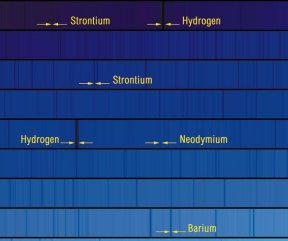Tracing the history of star formation in the Milky Way galaxy, astronomers have turned to the wisdom of the ancients.

Analyzing the composition of 70 of the oldest known stars in the galaxy—the largest such sample so far—scientists have found new evidence that a generation of short-lived stars preceded this elderly population. Moreover, the variation in composition among the old stars suggests that the oldest part of the Milky Way originated not in a single stroke of star formation but in bits and pieces that may have unfolded over several hundred million years.
In research they describe in the Nov. 20 Astrophysical Journal, Debra L. Burris of Oklahoma City Community College and her colleagues examined the abundance of elements heavier than iron in a group of old stars in the Milky Way’s halo.
This sphere of gas and stars, which extends outward from the core of the galaxy, is considered the most ancient part of the Milky Way.
According to the standard model, the Big Bang forged all the hydrogen and helium in the universe and also traces of lithium, beryllium, and boron. Then, stars brewed heavier elements in a process requiring lighter elements to capture neutrons. When stars die, their elements become part of interstellar gas clouds, which then coalesce into the next generation of stars.
Stars like the sun, which formed relatively recently, are enriched in heavy elements created in many previous generations of stars. In contrast, the ancient metal-poor stars examined by Burris’ team are billions of years old and serve as fossils reflecting the early composition of the Milky Way.
From spectra of the 70 stars in their study, the astronomers measured the relative abundance of heavy elements, creating a set of chemical fingerprints that can reveal the nuclear reactions and conditions that formed those elements.
The so-called rapid process requires the swift capture of many neutrons to create heavier elements. The slow process permits a lower rate of neutron capture.
The researchers found that the rapid process in the extraordinarily ancient stars they studied abruptly switched on when the iron content had reached about one-thousandth that of the sun. The flow of incoming neutrons to fuel this process probably originated in supernova explosions of yet an earlier generation of stars.
And that means that even these ancient stars weren’t the first to form in the galaxy, says Burris. The data also suggest that the rapid process didn’t kick in until stars 8 to 10 times as massive as the sun exploded as supernova.
The team found that over several hundred million to a billion years, the importance of the rapid process dwindled and the slow process began to dominate. Slow-process neutrons are supplied by lower-mass stars in their bloated, final stages.
“The large number of stars observed and the quality of the data make [this] the strongest confirmation yet of our picture of the chemical evolution of the galaxy,” says Andrew McWilliam of the Carnegie Observatories in Pasadena, Calif.
The striking variation in the abundance of heavy elements from star to star suggests “that the Milky Way’s history is complex” and that different locales in the galaxy have different star-formation histories, Burris notes. Assuming our Milky Way is a typical galaxy, astronomers may use these insights to gain a better understanding of distant galaxies in their infancy.







